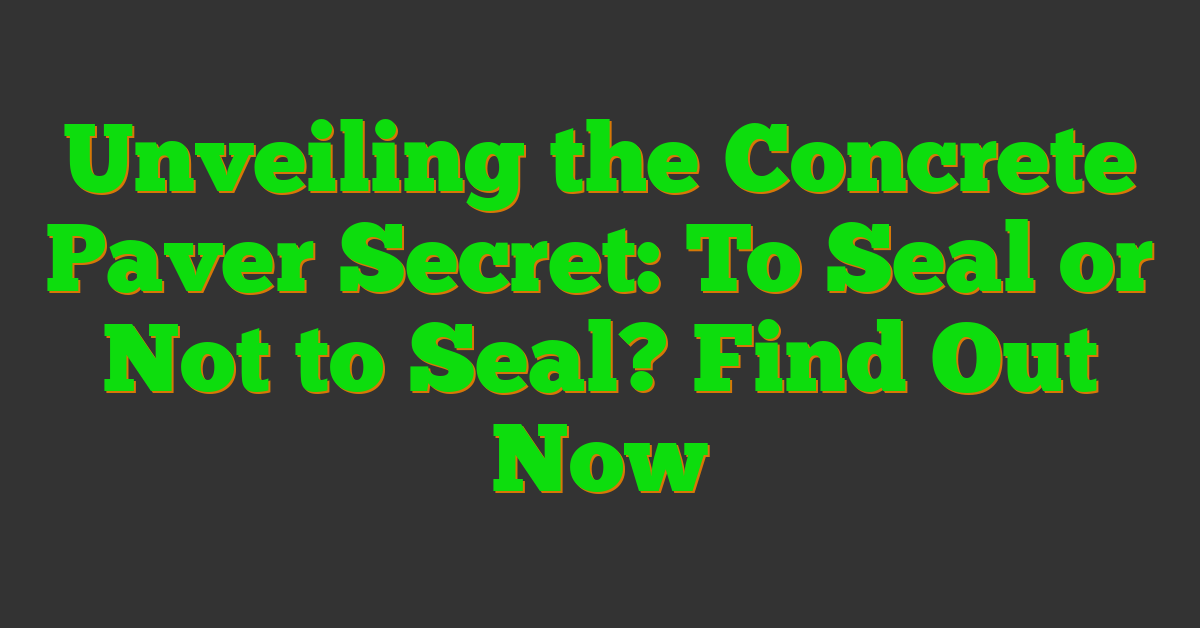When it comes to enhancing the longevity and appearance of your outdoor space, considering whether to seal your concrete pavers is a crucial decision. Sealing concrete pavers can offer a range of benefits, from protecting them against stains and weather damage to enhancing their color and durability.

In this article, we’ll explore the importance of sealing concrete pavers, the different types of sealers available, and the steps involved in the sealing process. Whether you’re a seasoned DIY enthusiast or a homeowner looking to spruce up your patio, understanding the role of sealing in maintaining your concrete pavers is key to ensuring they stand the test of time. Let’s dive into the world of concrete pavers and discover why sealing could be the missing piece in your outdoor maintenance routine.
Understanding Concrete Pavers
The Basics of Concrete Pavers
When it comes to designing outdoor spaces, concrete pavers play a crucial role in creating beautiful and durable landscapes. These versatile units are made from a mixture of cement, aggregate, and color pigment, offering a wide range of shapes, sizes, and textures to suit various design preferences.
Concrete pavers are known for their strength and durability, making them ideal for driveways, walkways, patios, and other hardscaping projects. Their interlocking design allows for easy installation and ensures stability over time. With proper maintenance, concrete pavers can withstand heavy traffic and weather conditions, providing long-lasting functionality and aesthetic appeal to outdoor areas.
Benefits of Using Concrete Pavers
Using concrete pavers in outdoor design projects offers a multitude of benefits. These versatile units are available in different colors and patterns, allowing for endless design possibilities. From creating intricate patterns to simple layouts, concrete pavers offer a customizable solution for enhancing outdoor aesthetics.
Concrete pavers are also easy to repair and replace individually, minimizing maintenance costs in the long run. Their natural slip resistance and ability to withstand freeze-thaw cycles make them a practical choice for various climates. Additionally, sealing concrete pavers can further enhance their lifespan by protecting against stains, color fading, and deterioration caused by UV exposure.
Incorporating concrete pavers into landscape designs not only adds visual appeal but also increases property value. Whether used for residential or commercial projects, concrete pavers are a versatile and durable option that can transform outdoor spaces into inviting and functional areas for years to come.
Sealing Concrete Pavers: Is It Necessary?
The Purpose of Sealing
When it comes to enhancing the longevity and aesthetics of outdoor spaces, sealing concrete pavers plays a crucial role in our designs.
Pros and Cons of Sealing Concrete Pavers
In our experience, sealing concrete pavers offers numerous advantages. It helps protect the pavers from stains, weather damage, color fading, and UV exposure, ensuring that our outdoor designs maintain their beauty over time. However, it’s essential to consider the potential downsides as well. Sealing may require periodic reapplication, and some sealants can alter the appearance of the pavers. Striking a balance between protection and maintaining the desired look is key in our landscape designs.
How Sealing Affects the Longevity of Concrete Pavers
As landscape designers, we understand the pivotal role that sealing plays in the life of concrete pavers. It’s not just about enhancing their visual allure; it’s also about ensuring their durability and resilience over time. By delving into the impact of sealing on the longevity of concrete pavers, we can appreciate the balance between protection and aesthetics that is crucial in our landscape designs.
Before and After: Comparing Sealed vs. Unsealed Pavers
When it comes to comparing sealed and unsealed pavers, the differences are stark. Sealed pavers boast a vibrant color that lasts longer, thanks to the protection against stains and UV exposure. On the other hand, unsealed pavers are susceptible to discoloration and weather damage, leading to a shorter lifespan. By sealing the pavers, we not only enhance their longevity but also maintain the desired appearance throughout the seasons.
Maintenance Requirements for Sealed Pavers
Maintaining sealed pavers is a key aspect of ensuring their longevity. Periodic reapplication of sealant is necessary to uphold the protective layer that shields the pavers from external elements. Additionally, regular cleaning and gentle care are vital to preserving the integrity of the sealed surface. By staying on top of maintenance requirements, we can prolong the lifespan of the concrete pavers and uphold the beauty of our landscape designs.
Choosing the Right Sealant for Your Pavers
Types of Sealants for Concrete Pavers
When it comes to selecting a sealant for your concrete pavers, it’s essential to understand the different types available. There are two primary categories to consider: film-forming sealants and penetrating sealants.
Film-forming sealants create a protective layer on the surface of the pavers. They offer excellent protection against stains, water damage, and UV exposure. However, they may alter the appearance of the pavers by adding a glossy or semi-gloss finish. Examples include acrylic sealers and polyurethanes.
On the other hand, penetrating sealants are absorbed into the pavers, providing protection from within. They are ideal for maintaining the natural look of the concrete while still offering protection against water infiltration and freeze-thaw damage. Silane and siloxane sealers are common types of penetrating sealants.
Consider the look you want to achieve and the level of protection needed when choosing between film-forming and penetrating sealants for your concrete pavers.
Factors to Consider When Selecting a Sealant
Several factors should guide your decision when selecting a sealant for your concrete pavers. Here are some key considerations:
- Durability: Choose a sealant that offers long-lasting protection against stains, weather damage, and UV rays to ensure the longevity of your pavers.
- Slip Resistance: Opt for a sealant that maintains or enhances the traction of your pavers to prevent slips and falls, especially in wet conditions.
- Breathability: Ensure that the sealant allows moisture trapped within the pavers to escape to prevent issues such as efflorescence and spalling.
- Ease of Application: Select a sealant that is easy to apply and maintain, taking into account factors like drying time and reapplication frequency.
- Aesthetic Effects: Consider how the sealant will impact the appearance of your pavers. Choose a product that enhances the color and texture of the concrete while providing the desired level of protection.
By weighing these factors and understanding the different types of sealants available, you can make an informed decision that best suits your concrete pavers’ maintenance and aesthetic needs.
The Sealing Process Explained
As landscape designers, we understand the importance of sealing concrete pavers to enhance their longevity and aesthetics. Sealing your pavers not only protects them from stains, weather damage, and UV exposure but also adds a beautiful finish to your outdoor space. Let’s delve into the details of the sealing process to help you maintain your concrete pavers effectively.
« Unlock the Secret to Boosting Your Outdoor Space with These Jaw-Dropping Paving Styles Discover the Top Secrets of Scoring the Perfect Pavers in Tucson »
Preparing Your Pavers for Sealing
Before sealing your concrete pavers, it’s essential to prepare them properly to ensure the best results. Here’s what you need to do:
- Clean the Surface: Start by thoroughly cleaning the pavers to remove any dirt, grime, or stains. Use a suitable cleaner and scrub brush to get rid of any debris lodged in the crevices.
- Repair Any Damage: Inspect the pavers for cracks or chips. Repair any damage before sealing to prevent moisture from seeping in and causing further deterioration.
- Allow Drying Time: Ensure the pavers are completely dry before applying the sealer. Depending on the weather conditions, this may take a day or two.
By following these steps, you’ll create a clean and sturdy surface that is ready for sealing.
Step-by-Step Guide to Sealing Concrete Pavers
Sealing concrete pavers is a straightforward process that can be done with the right tools and materials. Here’s a step-by-step guide to help you seal your pavers effectively:
- Choose the Right Sealer: Select a high-quality sealer suitable for your specific paver type and the desired finish. Consider factors such as durability, slip resistance, and enhancement of the pavers’ appearance.
- Apply the Sealer: Start by pouring the sealer into a paint tray. Use a long-handled paint roller to apply an even coat of sealer onto the pavers. Make sure to work in small sections to ensure thorough coverage.
- Allow Drying Time: Let the first coat of sealer dry as per the manufacturer’s instructions. Apply a second coat if needed for added protection and a more pronounced finish.
- Regular Maintenance: To maintain the integrity of the sealer, clean the sealed pavers regularly with a gentle cleaner and reapply the sealer as necessary to prolong their lifespan.
By following these steps, you can seal your concrete pavers effectively, keeping them looking great for years to come.
Alternatives to Sealing Concrete Pavers
As landscape designers, we understand the importance of protecting concrete pavers while also considering eco-friendly and maintenance-free options. Here, we explore alternatives to sealing concrete pavers that can enhance their longevity and appeal without the need for traditional sealants.
Enhancements Without Sealant
When aiming to avoid sealants, there are still effective ways to enhance the durability and look of your concrete pavers. One alternative is using polymeric sand in the joints between the pavers. This specialized sand hardens when activated by water, creating a stable bond that helps prevent weed growth and maintain the interlocking pattern of the pavers. Additionally, incorporating a high-quality joint stabilizing sealer can further enhance the integrity of the paver installation without the need for a full surface sealant.
Eco-Friendly Options for Paver Protection
For those seeking environmentally conscious solutions, several eco-friendly options can provide protection for concrete pavers. One such option is utilizing permeable pavers that allow water to pass through the surface, reducing runoff and promoting groundwater recharge. These pavers are not only environmentally friendly but also help prevent puddling and erosion. Another eco-conscious choice is using natural stone pavers that require minimal processing and have inherent durability, reducing the need for chemical sealants and promoting sustainability in your outdoor space.
Conclusion
Sealing concrete pavers is key to ensuring their longevity and enhancing their appearance. We’ve explored various sealant options and the importance of proper maintenance. Additionally, alternatives like polymeric sand and joint stabilizing sealers offer durability without full surface sealants. Eco-friendly choices like permeable pavers and natural stone options provide sustainable solutions for outdoor spaces. Remember, sealing your concrete pavers is a worthwhile investment for both protection and aesthetic appeal.
















